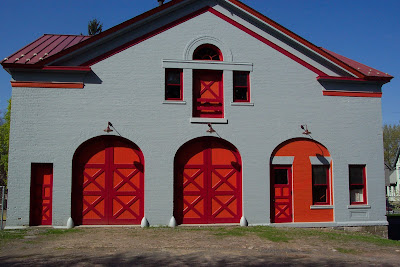 Who is Thomas Mott Osborne? And what is The Castle? These questions will be answered at the Auburn, NY premiere of a new documentary about Thomas Mott Osborne on Sunday, October 14 at 2:00 p.m. at Theater Mack at the Cayuga Museum. Filmmaker Neil Novello and Osborne biographer, David Connelly, will discuss the film after the screening. This program is free and open to the public.
Who is Thomas Mott Osborne? And what is The Castle? These questions will be answered at the Auburn, NY premiere of a new documentary about Thomas Mott Osborne on Sunday, October 14 at 2:00 p.m. at Theater Mack at the Cayuga Museum. Filmmaker Neil Novello and Osborne biographer, David Connelly, will discuss the film after the screening. This program is free and open to the public.
Thomas Mott Osborne’s statue stands in front of the Auburn, NY Police and Fire Departments. The Castle refers to the 105 year-old Portsmouth Naval prison that stands empty on a bluff in the Piscataqua River separating Maine and New Hampshire adjacent to the Portsmouth Naval Shipyard. But what do these two (Osborne & The Castle) have in common?
It is written in the Navy’s history of the Portsmouth Naval Prison aka The Castle that Thomas Mott Osborne “introduced a new era and a new viewpoint to the Naval prison.” From 1917 to 1921, Auburn prison reformer and resident, Thomas Mott Osborne, was the only civilian commander of the Naval Prison. Osborne hadn’t served in the Navy.
“Osborne is either a nut or a visionary,” says Pulitzer Prize winner and Auburn resident, David Connelly, who worked with Award-winning filmmaker Neil Novello from Maine on what is the only video documentary ever made about the Auburn industrialist turned humanitarian in the early 20th Century. The always-controversial Thomas Mott Osborne brought scandal, prison reform and a movie crew to the Portsmouth Naval Prison aka The Castle. ”Osborne’s command of the Naval Prison just maybe the culmination of Osborne’s prison reform career,” says Mr. Novello who started on this documentary five years ago.
Novello’s filmmaking journey started with his visit to the Syracuse University’s Bird Library to do research on Osborne. He went through box after box of Osborne’s history at the Naval Prison, which provided many great photos, newspaper articles, as well as Osborne’s writings. It was the Bird Library librarian who told Novello about Osborne biographer, David Connelly.
In the course of a year, David Connelly generously gave of his research time and family time to be a part of this documentary. Connelly knew Frederik (Erik) Osborne, TMO’s grandson, who had the remaining two reels of the Osborne-produced propaganda prison silent feature movie. “The Right Way” was filmed at the Naval Prison using prisoners as extras.
The other important person who gave generously of her time to Novello was Eileen McHugh, Director of the Cayuga Museum of Art and History. The Museum had a copy of Osborne in a 1926 experimental sound movie filmed at the Case Laboratories in Auburn where Osborne mentions the Portsmouth Naval Prison and talks about his reform ideas.
McHugh provided Mr. Novello an area in the basement of the museum to videotape David Connelly’s interview and McHugh also secured, via the Cayuga Museum’s archive, photos of early Auburn as well as Osborne and his family.
To understand Commander Osborne’s Naval prison experience, Novello needed to include Osborne’s family and his work at Auburn and Sing Sing state prisons in New York where he disguised himself as a prisoner to find out what life was like inside. When Osborne went to the Naval Prison, he disguised himself as a prisoner for a report to the Secretary of the Navy. While Commander of the Naval Prison, again Osborne disguised himself as a sailor and was a coal shoveler on the USS North Dakota as a way to understand Navy life.
Osborne became known for his Mutual Welfare League system where prisoners manage prisoners. The Mutual Welfare League was used at Auburn State prison and in Sing Sing state prison as well as the Naval prison.
With the additional photos provided by Ossining Historical Society in New York, and movie film (of Naval sea exercises and World War One) provided by the National Archive, Novello had the visual ingredients for his documentary about Osborne’s experience at the Naval Prison which in a way, culminates his prison reform career.
“It’s all about Osborne’s perspective and his thinking”, says Novello. “I did not want to make a run-of- the-mill, academic-type documentary with pros and cons. It’s about Osborne but told through his letters, film and David Connelly’s wonderful interview.”
Novello wanted to premiere TMO@The Castle in Auburn at the Cayuga Museum of Art and History’s newly restored Theater Mack. “It’s most fitting to show my documentary right here,” says Novello.
Novello has also produced a DVD called, The Castle: Stories of the Portsmouth Naval Prison which includes TMO@The Castle and a commentary to go with the remaining reels of Osborne’s feature movie, The Right Way.
 The Cayuga Museum of History and Art, in Auburn, New York, has announced the return of 21 objects of spiritual significance to the custody of the Onondaga Nation. Nineteen masks and two wampum articles associated with burials were transferred from the Museum collection to the Onondaga Nation.
The Cayuga Museum of History and Art, in Auburn, New York, has announced the return of 21 objects of spiritual significance to the custody of the Onondaga Nation. Nineteen masks and two wampum articles associated with burials were transferred from the Museum collection to the Onondaga Nation.






